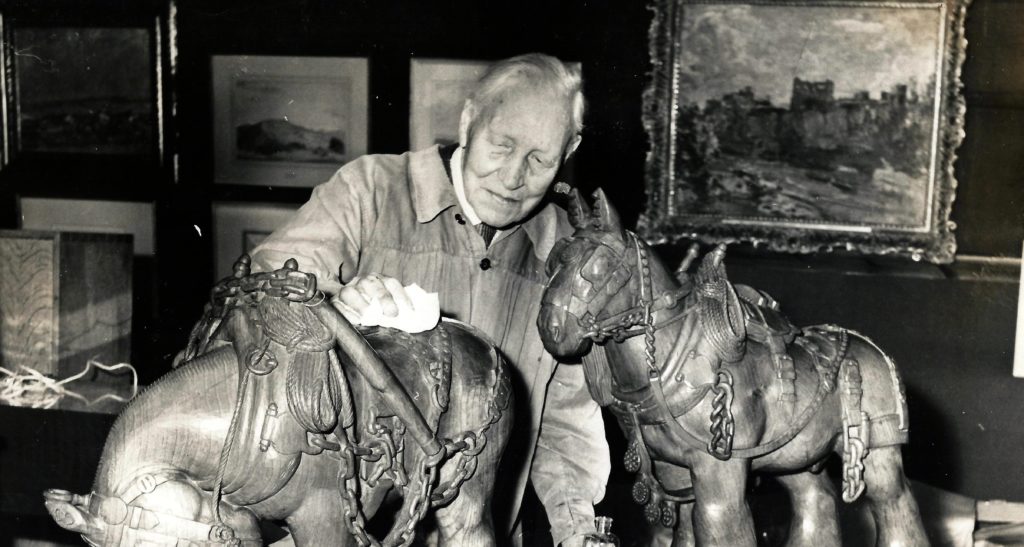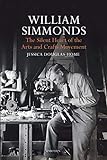I should have heard of William Simmonds. I must have read his name in connection with Rodmarton Manor, which I described for Country Life in 1978, and other Arts and Crafts undertakings at the turn of the twentieth century. But I confess that before opening this exceptional book I had no idea who he was. How ignorant I now feel.
Simmonds emerges as an enthralling figure, remarkable not just as a puppeteer but as a witness to his age, to whom extraordinary things somehow simply happened. He can hardly be held responsible for his place of birth—Constantinople, now Istanbul—but, typically, it was a highly flavored location. His father, a builder and carpenter, had been commissioned to help construct the British embassy there. It was a violent city, in which a “large black thing floating in the water” of the Bosphorus might turn out to be the beheaded bodies of forty priests suspected of insurrection. Europeans were unpopular and so it was best to carry a paper lantern and pistol when out at night. The family returned home in 1876, shortly after William’s birth. It was a fiery beginning for a man who grew up to be peaceable in all his tastes.
The Constantinople episode is not well recorded, but for the rest of Simmonds’s life, the level and variety of documentation is a biographer’s dream. Jessica Douglas-Home makes full use of it, in elegant prose. We can follow his life, friendships, marriage, and artistic career in thrilling detail. A working-class boy, he refused to follow his father’s trade, becoming instead a penniless art student at the National Art Training School in London. This offered what now seems to have been a stultifying curriculum, based on endless copying—made worse, no doubt, by the segregation of the sexes. (A female friend of Simmonds who wanted to hear a lecture by the embroiderer May Morris could only do so, in the absence of a suitable aunt, when chaperoned by the cook.)
After five years, he progressed to the Royal Academy Schools, which brought him into direct contact with the titans of the annual Royal Academy exhibition, many of whom taught students. There was not much method to this program. Teachers would contradict each other. Some could be incoherent or shy. John Singer Sargent was in this latter category—until he got to work on a student’s painting, when
his stuttering and hesitation gradually left him and he would grab their paintbrush with eyes aglow, his certainty intense, his movements confident, bursting with energy and dynamic enthusiasm. In a fever of conviction and concentration, he would stand at the easel, brush in hand, arm outstretched, head thrown back as his hand danced across the canvas. These performances, those of a man given over to the service of art, burnt themselves into William’s mind.
In 1900, Simmonds joined the fifty or sixty students who, in their painting smocks, pulled a giant statue of Colonel Robert Baden-Powell through the streets of London after the Relief of Ladysmith during the Boer War.
In 1904, Simmonds was invited to join one of his teachers, the American Academician Edwin Abbey, in his studio in the Cotswolds, that dreaming, idyllic corner of England, still plowed by oxen, that was becoming a center of the Arts and Crafts movement. This period was also the high point of the Beaux-Arts, and if you have ever wondered how one artist could supply the acres of canvas necessary to decorate the halls of the great civic buildings of the United States, Douglas-Home provides a fascinating case study. Abbey was at work on murals for the Pennsylvania State Capitol at Harrisburg. He had taken on not only this mighty commission but several others—which would prove considerably more than he could handle (eventually he went mad). At Harrisburg are four lunettes measuring thirty-eight by twenty-two feet, accompanied by four circular medallions that were fourteen feet in diameter. The studio itself was reputed to be, physically, the largest in the world. It had been made out of a barn that was sixty-four feet long. Abbey saw his own role in Renaissance terms: he was the intellect behind the designs, consumed by research into period detail. Mrs. Abbey made the costumes in which models would be posed. Simmonds and his friend Frederick George Swaish clambered up and down ladders, painting from Abbey’s sketches; another assistant was Ernest H. Shepard, less talented as a painter than as the original illustrator of A. A. Milne’s Winnie-the-Pooh. Despite Abbey’s mounting stress and exhaustion, they were happy times.
By the end of the decade, Simmonds was able to set up on his own, producing book illustrations; in 1907, a painting of his was hung in the Royal Academy’s prestigious summer exhibition. Five years later, at age thirty-six, he married Eve Peart, a pupil of Walter Sickert, who both loved the natural world as Simmonds did and could play the spinet, having taken lessons with that pioneer of early music, Arnold Dolmetsch. In a dismally cold spring and summer (under the ash cloud of a volcanic explosion in Alaska), the Simmondses moved into a Wiltshire cottage. They were visited by a stream of Eve’s arty and Arts-and-Craftsy friends, and William began to move away from painting towards sculpture. His first puppet show was put on as a village entertainment. It became an annual affair, growing ever more serious over the years.
It’s clear that Simmonds had a genius for puppets. This is evident from the illustrations in the book. No photograph, however, can do justice to the liveliness of the carving; and no inert puppet, hung up in a showcase, is more than a shadow of the same being when it is set in motion by the puppeteer. As well as a superb eye for character, Simmonds knew how to make his figures come alive. Eve provided musical accompaniment. But for all Simmonds’s talents to coalesce, something else was needed—and that came, tragically, with the catastrophic destruction wrought by the First World War. Afterwards, England yearned for the innocence of its pre-industrial past, and Simmonds’s puppet shows provided just the enchantment that his public needed.
The war itself provided a hiatus. Simmonds spent it, characteristically, in a remarkable and unexpected place, as a draftsman in Colonel R. E. B. Crompton’s laboratory, developing the first, top-secret “landships”—later known as tanks. The joints connecting early caterpillar tracks were not so different from those articulating stringed puppets. As a pacifist, Simmonds was lucky to have this bona fide war work, which enabled him to escape the humiliations imposed on other conscientious objectors.
After 1918, Simmonds again heard the call of the Cotswolds and joined Ernest Gimson, Sidney and Ernest Barnsley, Alfred Powell, and the rest of the Arts and Crafts community there. Through the Arts and Crafts supremo Detmar Blow, the puppets came to the notice of the (evil) Duke of Westminster, and Simmonds performed for a house party at Eaton Hall. The circle of admirers grew. In 1922, one of a series of articles in The Times, reviewing a performance that contained nymphs, fauns, and hamadryads, evokes Simmonds’s expertise as a manipulator of his creations:
Little Faun twirls high in the air and squats on the ground as a faun should, but as you would suppose no puppet could. Young Centaur kicks out with his hind legs. The Forester kneels behind his bush as easily as though he were flesh and blood. The wild dance of joy between the two fauns is wild indeed, but in perfect unison. It is almost impossible to think that these tiny figures are all wire-pulled: they seem to be endowed with life.
Eve may seem to be rather shortchanged in all this. Her time came with a vengeance when she fell under the influence of the harpsichord player Violet Gordon-Woodhouse, who lived in a ménage à cinq composed of her husband and four other men. Poor Eve was out of her league. Every year for sixteen years she made Violet a birthday bonnet, most of which seem never to have been worn. She lurched into a hopeless relationship with a member of the male entourage, high points of which were recorded by a secret symbol in her diary. If Simmonds noticed—and how could he not?—he did not comment. The rigors of Arts and Crafts life, eschewing the comforts of the twentieth century, demanded stoicism, and Simmonds kept his eyes on his workbench, crafting not only puppets but animal sculptures. Thirteen of them were exhibited at the Festival of Britain in 1951, along with two embroideries by Eve. Later, he was visited by the author of this book when she was a young girl; she hoped he would sculpt her whippet, though he never did. As a tribute to an unusual and gifted man, this book may have had a long gestation, but it’s as much a masterpiece as the puppets.


